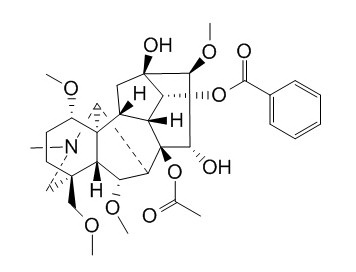Natural Products
Hypaconitine
| Catalog No. | CFN99200 |  |
| CAS No. | 6900-87-4 | |
| Molecular Weight: | 615.71 | |
| Molecular Formula | C33H45NO10 | |
| DBs | [PubChem]:274950950 [ChEMBL]:5831 [PCIDB]: |
Standard InChI:
InChI=1S/C33H45NO10/c1-17(35)44-33-21-19(14-31(38,28(42-6)26(33)36)27(21)43-29(37)18-10-8-7-9-11-18)32-20(40-4)12-13-30(16-39-3)15-34(2)25(32)22(33)23(41-5)24(30)32/h7-11,19-28,36,38H,12-16H2,1-6H3/t19-,20+,21-,22?,23+,24-,25-,26+,27-,28+,30+,31-,32+,33-/m1/s1
Biological Activity
Hypaconitine (HA), an active and highly toxic constituent derived from Aconitum species, is widely used to treat rheumatism, the hepatic cytochrome P450-catalyzed metabolism of HA. [1]
Hypaconitine, aconitine (AC) and mesaconitine(MA) are aconitum alkaloids, have highly toxic, however, their hydrolysates are considerably less toxic; the intracellular amounts in the presence of inhibitors, P-gp and BCRP were involved in the transport of AC, MA and HA; and MRP2 might transport AC, MA, and HA.[2]
Hypaconitine and aconitine produce neuromuscular blockade by reducing the evoked quantal release, the mechanism of this effect was attributed mainly to blocking of the nerve compound action potential.[3]
Hypaconitine induces QT prolongation, mediated through inhibition of KCNH2 (hERG) potassium channels in conscious dogs.[4]
Hypaconitine can inhibit CaM expression and Cx43 (Ser368) phosphorylation, and liquiritin can interfere with this kind of effect by synergistically inhibiting CaM expression and by antagonizing Cx43 (Ser368) dephosphorylation induced by hypaconitine.[5]
Product
References
[1] Ye L, Wang T, Yang C, et al. Toxicol Lett, 2011, 204(1):81-91.
[2] Ling Y, Yang X, Zhen Y, et al. Toxicol Lett, 2013, 216(2-3):86-99.
[3] Muroi M, Kimura I, Kimura M. Neuropharmacology, 1990, 29(6):567-72.
[4] Xie S, Ying J, Liu A, et al. J Ethnopharmacol, 2015, 166:375-9.
[5] Yi M, Peng W, Chen X, et al. J Pharm Pharmacol, 2012, 64(11):1654-8.
[6] Zheng H S, Feng N P. Chinese Journal of Pharmaceutical Analysis, 2005, 25(1):34-6.
Product Use Citation





